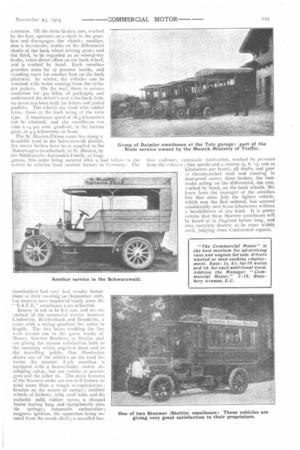German Activity.
Page 32

Page 33

If you've noticed an error in this article please click here to report it so we can fix it.
Self-Propelled Fire Engines and Omnibuses on the Increase.
That motor plant should have begun to replace horsedrawn machines in the fire-extinguishing appliances of
The tank holds 22.5 gallons of petroleum —sufficient for a t6-mile run, and an hour's operations at the lire. In speed, the Sclii_ineberg engine far excels its lEanover prototype : its top speed touches 22 Miles an hour, or nearly 10 miles more. For this rate of travelling, .a 2511.1>. coinpound engine is found necessary_ Speed and direction are controlled by levers from the driver's seat. Over and above the steam brake (reverse) there is an efficient band brake applied to the back wheels; but as the driver can, by using the reversing lever, bring about any braking effect, down to a dead stop, the band brake conies into play in emergencies only. One man can both steer and regulate the tire engine, yet experience has shown that it is MOM practical to divide these functions between a couple of men, putting cne at the steeling wheel and the other at the regulator lever. Power is transmitted to the roar wheels by chains and sprockets; there is room on the machine for seven men and equipment.
The addition of new omnibus routes in Germany, above those already reported in our pages, serves to remind us in England that Other countries are keenly alive to the great possibilities of this form of passenger transport. We illustrate two typical Blaok Forest routes in our issues of August Toth and September 21st, and a few more examples of C;erman activity are now given, solely as an antidote to the dangerous inclination— so peculiarly dear to us by reason of our insular prejudices— To believe that: thmt Britain only is to the fore in this fresh development in the means of internal communication. The type of (minibus delivered by he Daimler Motoren Gesellschaft to the Munich Ministry of Traffic, for the TolzLeng-gries State line, is not unknown in England. Similar vehicles are running in Eastbourne, London, and other places too numerous to mention. It' is equipped uith a fourcylinder motor, developing 2911.p. at Sao revolutions per minute. Both inlet and outlet valves are mechanically operated by ram shafts. Ignition on the low tension magnetoelectric makc-and-break system, with " spray " carburetter, centrifugal regulator, Merades bee-hive radiator, frictionclutch, etc., arc used. The omnibuses have four speeds and a reverse. Of the three brakes, one, worked by the foot, operates on a shaft in the gearbox and disengages the clutch; another, also a foot-brake, works on the differential shafts of the back wheel driving gear; and the third, to be regarded as an emergency brake, takes direct effect on the back wheel, and is worked by hand. Each omnibus provides seats for 17 persons inside, and standing room for another four on the back platform. In winter, the vehicles can be warmed with water coining from the cylinder jackets. On the roof, there is accommodation for 300 kilos. of packages, and underneath the driver's seat a tin-lined, lockup space has been built for letters and postal packets. The wheels arc shod with rubber tyres, those at the back being of the twin type. A maximum speed of 18.5 kilometres can be attained, and the omnibuses can take a 14 per cent, gradient, in the bottom gear, at 4.5 kilometres an hour.
The St. Blasien-Titisee route lies along a beautiful road in the Schwarzwald district. Six motor brakes have been supplied to the Motorwagen Gesellschaft, of St. Blasien, by the Siiddeutsche Automobil-Fabrik, of Gaggenau, this order being secured after a bad failure in the service by vehicles from another factory in Germany. The shareholders had very bad results before them at their meeting 011 September 29th, but matters have improved vastly since the " S.A.F.E." omnibuses were delivered.
. Saxony is not to be left out, and we are advised of the successful service between Lindenfels, Reichenbach and Bensheim, a route with a tryinggradient tiv..i miles in length. The two buses working the line were turned out in the great works of Messrs. Stoewer Brothers, at Stettin, and are giving the utmost satisfaction both to the company which acqoired them and to the travelling public. Our illustration shows one of the vehicles on the road between the termini. Each omnibus is equipped. with a four-cylinder motor developing 24h.p., but one carries 12 passengers and the other 16. The main features of the Stoewer make are too well known to need more than a rough re-capitulation : benzine as the source of energy ; artillery wheels of hickory, with keel hubs and detachable solid rubber tyres; a channel frame having long and exceptionally elas tic springs; automatic carburation ; magneto ignition, the apparatus being rotated from the crank shaft ; it so-called bee.
bive radiator; automatic lubrication, worked by pressure from the exhaust ; four speeds and a reverse (5, 8, :5, and 22 kilometres per hour); all shafts and gear of chrome-nickel steel and running in dust-proof eases; three brakes, the footbrake acting on the differential, the rest, worked by hand, on the back wheels. We learn from the manager of the omnibus line that since July the lighter vehicle, which was the first ordered, has covered considerably over 8,noo kilometres without it breakfldown of any kind. It is pretty certain that these Stoewer omnibuses will be heard of in England before long, and they certainly deserve to be more widely used, judging front Continental reports.








































